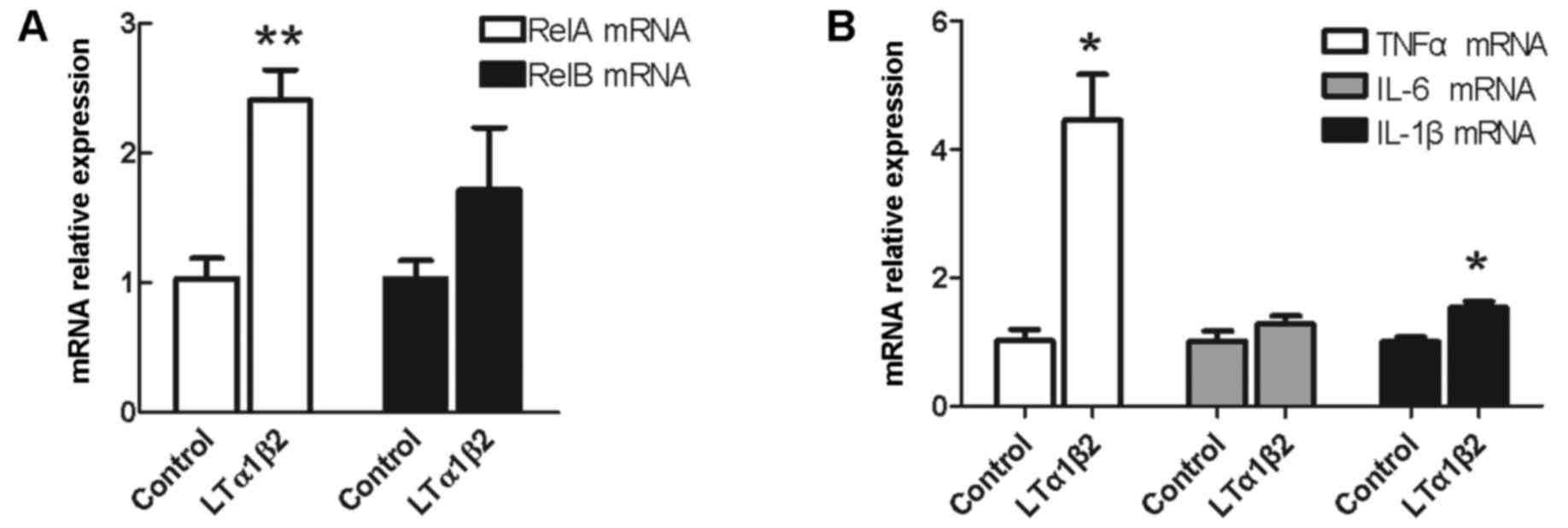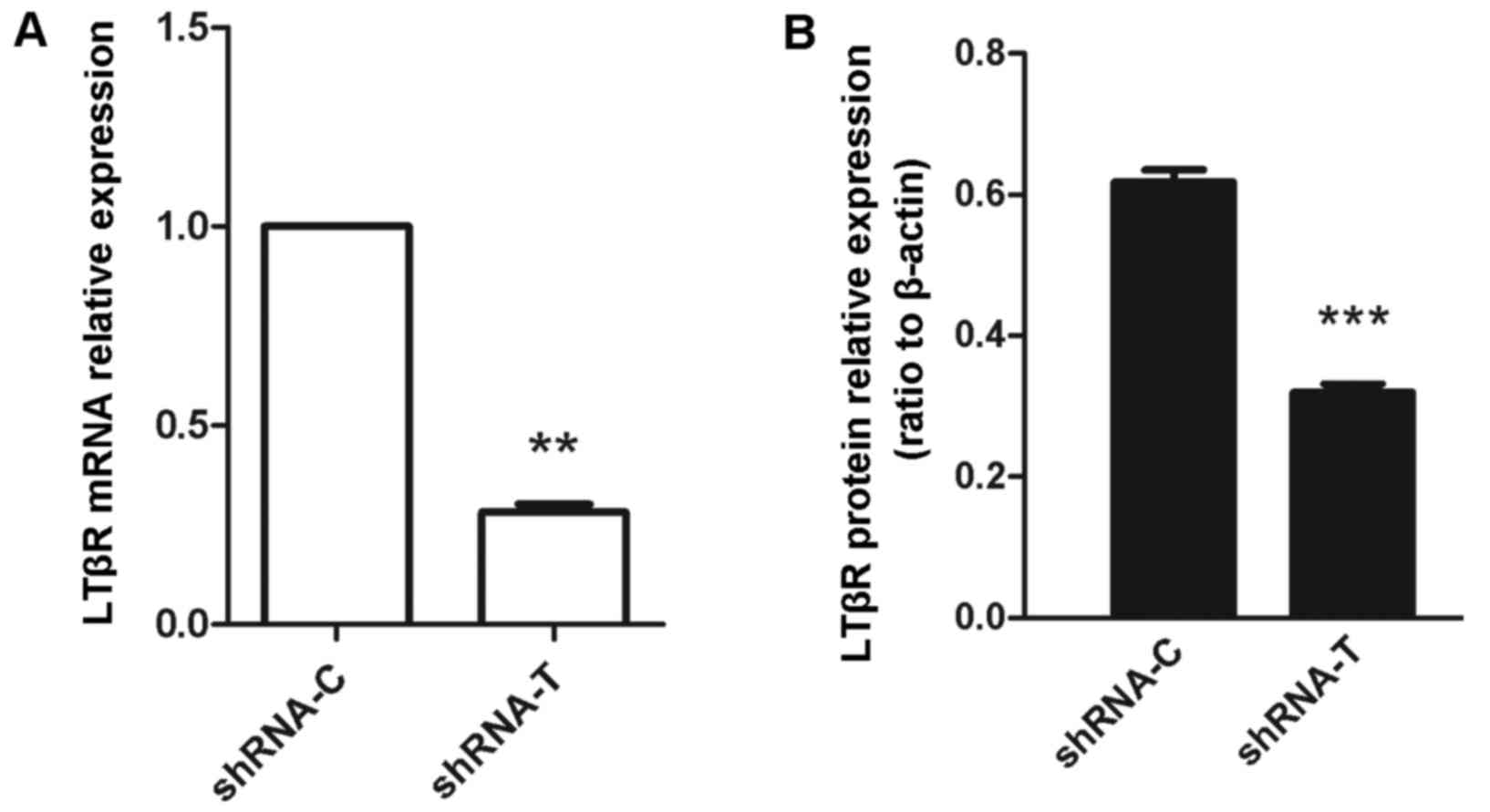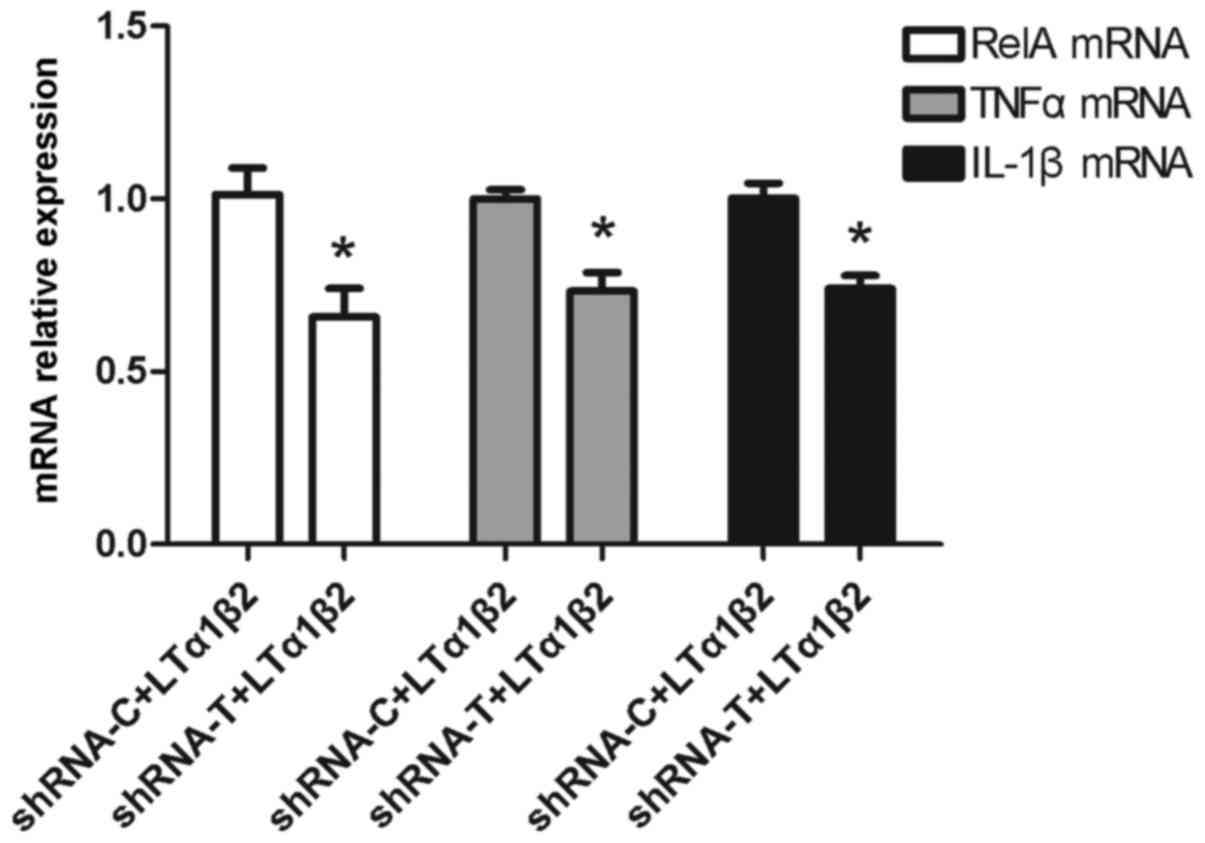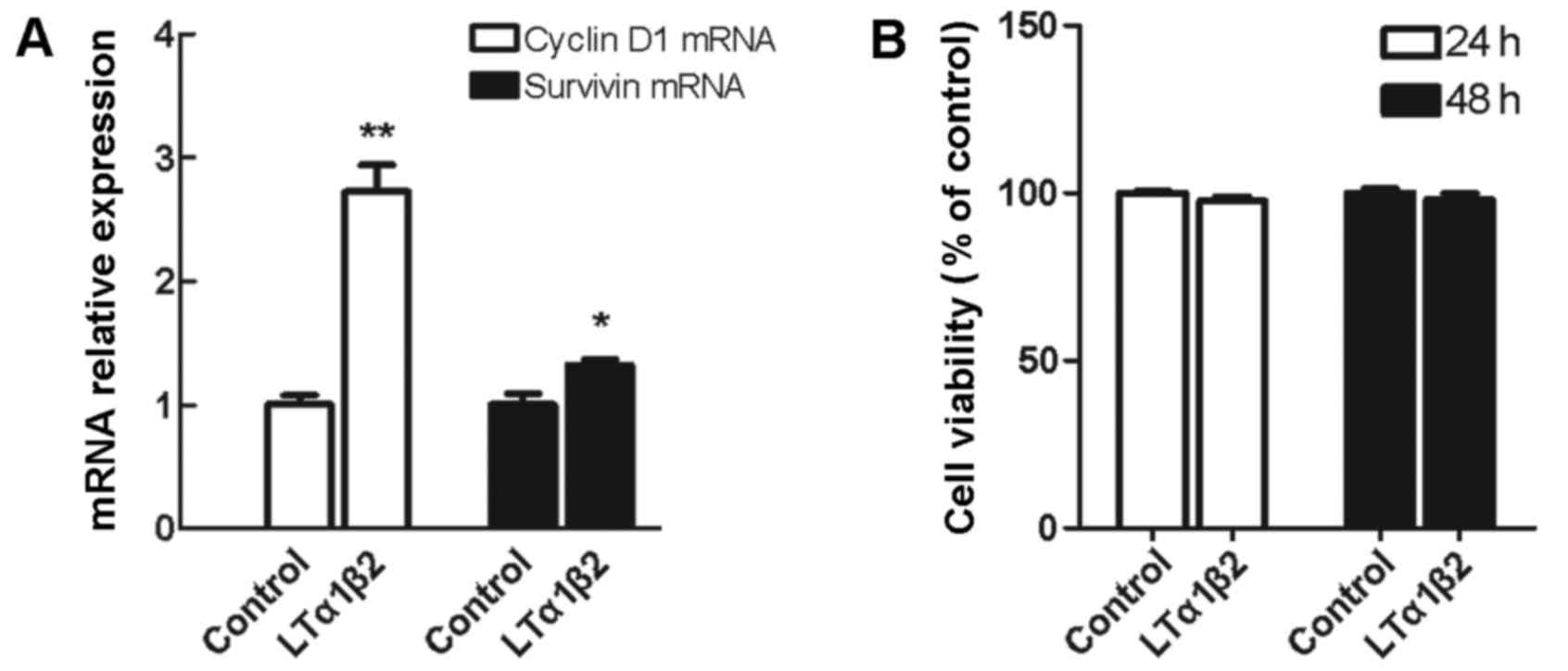Lymphotoxin β receptor activation promotes mRNA expression of RelA and pro-inflammatory cytokines TNFα and IL-1β in bladder cancer cells
- Authors:
- Published online on: June 1, 2017 https://doi.org/10.3892/mmr.2017.6676
- Pages: 937-942
Abstract
Introduction
The role of inflammation in tumorigenesis and development is now well established in the biomedical literature. There is mounting evidence that an inflammatory microenvironment is an essential component of most tumor types, including some in which the causal relationship with inflammation remains to be elucidated (1). In some cancer types, inflammatory conditions precede development of malignancy; in others, oncogenic change induces a tumor-promoting inflammatory milieu (1,2). Globally, there are large variations in bladder cancer mortality (3,4), suggesting an important role of environmental factors in the etiology of bladder cancer. The common known risk factors of bladder cancer include a number of occupations with exposures to aromatic amines (for example, industrial dye manufacturing), the drug cyclophosphamide, cigarette smoking, and chronic infection (for example, urinary tract infections and schistosomiasis) (5). The unifying principle that underlies these risk factors is chronic inflammation, which is an aberrantly prolonged form of a protective response to the loss of tissue homeostasis (6). A previous study from our group reported great numbers of immune cells infiltrated in bladder cancer tissue from patients (7), suggesting a strong relationship between bladder cancer and chronic inflammation. Immune cells that infiltrate tumors engage in a dynamic crosstalk with cancer cells, resulting in the inflammatory tumor microenvironment. Understanding the underlying mechanisms of how immune cells function in different tumor types, and which molecular inflammatory mediators might drive or potentially prevent carcinogenesis, is a subject of intense research.
Lymphotoxin β receptor (LTβR) was initially discovered in the context of lymph node development, and it has since been demonstrated that LTβR signaling participates in the initiation and/or development of inflammation-induced carcinogenesis (8). LTβR is expressed in a wide range of tumor types, including breast, colorectal, lung, stomach, melanoma and bladder cancer (9,10), while its ligands, lymphotoxin (LT) a1b2 and TNF superfamily member 14 (TNFSF14; also known as LIGHT), are mainly expressed on the surface of immune cells (11). Thus, LTβR signaling might enable the communication between infiltrating immune cells and tumor cells (8). Triggering LTβR induces the canonical and noncanonical nuclear factor (NF)-κB signaling pathways, which are linked to inflammation-induced carcinogenesis (12). Sustained LTβR signaling leads to NF-κB-mediated chronic inflammation and hepatocellular carcinoma (HCC) development (13). Long-term suppression of LTβR with a LTβR agonistic antibody significantly reduces chronic hepatitis incidence and prevents the transition from chronic hepatitis to HCC in mouse models (13). By contrast, LTβR functions as a death receptor that mediates tumor cell apoptosis in colon carcinoma, mammary carcinoma and sarcoma (14); Yang et al (15) and Winter et al (16) reported that LTβR induces cytotoxic T lymphocyte-mediated antitumor cytotoxicity. Because of these contrasting observations, the function of LTβR signaling might be tumor type and cellular context-dependent. In addition, the function of LTβR remains unclear in bladder cancer. Therefore, the present study aimed to investigate the effect of LTβR activation on the mRNA expression levels of the NF-κB main members, RELA proto-oncogene (RelA; also known as p65) and RELB proto-oncogene (RelB) and to analyze the function of LTβR in the proliferation and the pro-inflammatory response in bladder cancer cells.
Materials and methods
Cell culture
Human bladder cancer 5,637 cells were purchased from the Cell Bank of Type Culture Collection of the Chinese Academy of Sciences (Shanghai, China) and maintained in RMPI-1640 (Gibco; Thermo Fisher Scientific, Inc., Waltham, MA, USA) supplemented with 10% fetal bovine serum (FBS; Biowest, Nuaillé, France) at 37°C humidified atmosphere with 5% CO2. For the present study, 5,637 cells were seeded onto 96-well plates, 24-well plates and 6-well plates at densities of 4–5×104 cells/ml, 2–5×105 cells/ml and 1–2×106 cells/ml respectively. Cells were then divided into two experimental groups, LTβR-activated and LTβR-silenced. Activation of LTβR was induced by addition of the functional ligand, lymphotoxin (LT) α1β2 (R&D Systems, Inc., Minneapolis, MN, USA), at a final concentration of 100 ng/ml. Silencing of LTβR was performed by specific LTβR small hairpin RNA (shRNA). Prior to each experiment, cells were grown in RPMI-1640 without FBS for 6 h.
Reverse transcription-quantitative polymerase chain reaction (RT-qPCR)
Total RNA was extracted from 5,637 cells using TRIzol reagent (Thermo Fisher Scientific, Inc.), following the manufacturer's instructions. Total RNA of each sample (2 µg) was subjected to oligo-dT-primed RT using the RevertAid First Strand cDNA Synthesis kit (Thermo Fisher Scientific, Inc.), according to the manufacturer's instructions. The resulting cDNA was diluted 1:20 used for qPCR, using a SYBR-Green Real-Time PCR Master mix on a 7500 Real-Time PCR System (both from Applied Biosystems; Thermo Fisher Scientific, Inc.). Primer sequences were as follows: human LTβR, sense 5′-GCACAAGCAAACGGAAGACC-3′ and antisense 5′-GACCTTGGTTCTCACACCTGGT-3′; LTα, sense 5′-CTGCTCACCTCATTGGAGAC-3′ and antisense 5′-CCTGGGAGTAGACGAAGTAGAT-3′; LTβ, sense 5′-CAGCTGCCCACCTCATAGG-3′ and antisense 5-GCGTCCGAGAACTGCGTC-3′; LIGHT, sense 5′-ATCTCACAGGGGCCAACT-3′ and antisense 5′-ACGGACGACCACCTTCTC-3′; tumor necrosis factor (TNF)α, sense 5′-GCCCATGTTGTAGCAAACC-3′ and antisense 5′-GGTAGGAGACGGCGATG-3′; IL-6, sense 5′-AATTCGGTACATCCTCGACGGC-3′ and antisense 5′-GCCAGTGCCTCTTTGCTGCTTT-3′; interleukin (IL)-1β, sense 5′-GAAATGATGGCTTATTACAGTGGCA-3′ and antisense 5′-GTAGTGGTGGTCGGAGATTCGTAG-3′; CyclinD1, sense 5′-TGCATCTACACCGACAACTCC-3′ and antisense 5′-GGGCGGATTGGAAATGAACT-3′; and Survivin, sense 5′-GACCACCGCATCTCTACATTCA-3′ and antisense 5′-AATTCACCAAGGGTTAATTCTTCAA-3′. qPCR was performed under the following conditions: initial denaturation at 95°C for 5 min, then 45 cycles of 95°C for 30 sec and 60°C for 30 sec. Melting curves were recorded to verify the singularity of the PCR product. In each sample, the level of cDNA was normalized to the level of GAPDH (sense 5′-GTCAACGGATTTGGTCGTATTG-3′ and antisense 5′-CTGGAAGATGGTGATGGGATT-3′). Relative fold changes in mRNA expression were calculated using the formula 2−ΔΔCq (17).
LTβR gene silencing by shRNA. The shRNA sequences were designed to exhibit sequence homology to the two LTβR transcripts (NM_0,01270987.1, NM_002342.2) at http://rnaidesigner.invitrogen.com/rnaiexpress/rnaiDesign.jsp (BLOCK-iT™ RNAi Designer; Thermo Fisher Scientific, Inc.). Bladder cancer 5,637 cells were transfected with LTβR-specific shRNA (5′-GCACCTATGTCTCAGCTAAAT-3′, loop sequence is CGAA) plasmid as the tested group (shRNA-T), in parallel with scramble shRNA (5′-CTACACAAATCAGCGATTT-3′, loop sequence is CGAA) plasmid as the control group (shRNA-C). The day prior to transfection, 5,637 cells were seeded into 24-well (7–9×105 cells/ml) or 6-well (1–2×106 cells/ml) culture plates in complete media. The next day, shRNA (at final concentration 0.8 and 4 µM for 24-well and 6-well culture plates, respectively) were introduced into cells using Lipofectamine 2000 (Thermo Fisher Scientific, Inc.) following the manufacturer's instructions. At 4 h post-transfection, media were replaced with regular complete culture media. The cells were cultured for 72 h prior to analysis of the gene-silencing effects. The expression of LTβR in the shRNA-transfected cells was characterized by RT-qPCR and western blotting.
Western blotting
For determining the silencing effect of the shRNA plasmid, 5,637 cells were cultured in 6-well plates (1–2×106 cells/ml) and transfected with the shRNA for 72 h. Total cells were lysed on ice with radioimmunoprecipitation assay lysis buffer (cat. no. P0013B; Beyotime Institute of Biotechnology, Nantong, China) supplemented with a protease inhibitor cocktail (cat. no. I3786; Sigma-Aldrich; Merck KGaA, Darmstadt, Germany) for 10–15 min. The concentration of protein in the lysates was measured by an Enhanced Bicinchoninic Assay kit (cat. no. P0010S; Beyotime Institute of Biotechnology). A total of 30 µg lysate was loaded onto each lane of 5% stacking gel and 8% separating gel and separated by SDS-polyacrylamide gel electrophoresis. Following SDS-PAGE, proteins were transferred onto polyvinylidene fluoride membranes (Solarbio Science and Technology Co., Ltd., Beijing, China). Membranes were subsequently blocked with 5% bovine serum album (BSA) (Generay Biotech Co., Ltd., Shanghai, China) diluted in TBST (10 mM Tris-HCL, 100 mM NaCl, 0.2% Tween-20) at 37°C for 2 h. After blocking, membranes were incubated with primary antibodies against LTβR (cat. no. 20331-1-AP; ProteinTech Group, Inc., Chicago, IL, USA) diluted 1:500 in TBST containing 5% BSA and β-actin (cat. no. GTX124213; GeneTex, Inc., Irvine, CA, USA) diluted 1:5,000 in TBST containing 5% BSA overnight at 4°C. Membranes were subsequently probed with a horse radish peroxidase-conjugated goat anti-rabbit immunoglobulin G secondary antibody (cat. no. A0208; Beyotime Institute of Biotechnology) diluted 1:1,000 in TBST containing 5% BSA at room temperature for 2 h. Immunoreactivity was visualized using an Enhanced Chemiluminescence reagent (cat. no. K-12045-C20; Advansta, Inc., CA, USA). Densitometric analysis was performed using Quantity One software version 4.6.2 (Bio-Rad Laboratories, Inc., CA, USA).
Cell viability assay
Cell viability was measured using the Cell Counting Kit-8 (CCK-8) (Dojindo Molecular Technologies, Inc., Kumamoto, Japan), according to the manufacturer's protocol. Briefly, 5,637 cells were seeded in 96-well plates at a density of 4–5×104 cells/ml and stimulated with LTα1β2 for 24 and 48 h. Control cells were treated with equal volumes of sterile PBS. At the indicated time point, the culture media was aspirated and fresh media supplemented with 10% (v/v) CCK-8 was added to the cells. Cells were cultured at 37°C for an additional 3 h and the absorbance was then measured at a wavelength of 450 nm. Cell viability was expressed as % of the control unstimulated culture measurement.
Statistical analysis
All statistical analyses were performed using SPSS version 15.0 software (SPSS, Inc., Chicago, IL, USA). Independent t tests between two groups were performed to determine statistical significance. P<0.05 was considered to indicate a statistically significant difference. Experiments were repeated three times.
Results
Activation of LTβR enhances the mRNA expression of RelA, but not of RelB
Activation of NF-κB signaling occurs by two pathways, the canonical pathway and the noncanonical signaling pathway. In order to examine the effect of LTβR activation on the expression of the main members of the canonical and noncanonical NF-κB signaling pathways, the RelA and RelB genes were selected as target genes, respectively. As demonstrated in Fig. 1A, RelA mRNA expression levels were upregulated by 2.5-fold following activation of LTβR in bladder cancer 5,637 cells, compared with control unstimulated cells (P=0.003). No significant difference was observed in the expression of RelB mRNA following LTβR activation compared with control unstimulated cells (P=0.254; Fig. 1A).
Activation of LTβR promotes the mRNA expression of pro-inflammatory cytokines TNFα and IL-1β
It is known that cytokines are major mediators of communication between cancer cells and immune cells in the inflammatory tumor microenvironment (2). The hypothesis that major pro-inflammatory cytokines, TNFα, IL-6 and IL-1β, which are also target genes of NF-κB signaling, might be regulated by LTβR was examined. As demonstrated in Fig. 1B, mRNA expression levels of TNFα were increased by ~5-fold (P=0.034) and IL-1β by 1.5-fold (P=0.013) following LTβR activation compared with control unstimulated cells. No effect on the expression of IL-6 mRNA was observed (P=0.334; Fig. 1B).
LTβR-induced upregulation of RelA, TNFα and IL-1β is reversed by LTβR silencing
To determine whether activation of LTβR has a causative role in the upregulation of NF-κB signaling members and pro-inflammatory cytokines, LTβR was silenced in 5,637 cells by shRNA. LTβR-specific shRNA (shRNA-T group) and non-silencing shRNA plasmids (shRNA-C group) were transfected into the 5,637 cells. The efficiency of LTβR silencing was confirmed at the mRNA and protein level by RT-qPCR and western blot, respectively (Fig. 2). Compared with the control group, expression of LTβR in cells transfected with LTβR-specific shRNA was reduced by 65–75% at the mRNA level (P=0.001; Fig. 2A) and ~50% at the protein level (P<0.001; Fig. 2B). Compared with the shRNA-C group, RelA mRNA expression was downregulated by ~33% (P=0.012), TNFα by 27% (P=0.011) and IL-1β by 26% (P=0.011) in the shRNA-T group following activation of LTβR (Fig. 3).
Activation of LTβR has no effect on 5,637 cell growth despite increased mRNA expression of proliferation-related genes CyclinD1 and Survivin
There are contrasting observations regarding the role of LTβR signaling pathway in tumor cell apoptosis and growth promotion. In the present study, LTβR activation in 5,637 cells resulted in a 2.7-fold upregulation of CyclinD1 mRNA expression levels (P=0.002) and a 1.3-fold upregulation of Survivin mRNA expression levels (P=0.035), compared with control unstimulated cells (Fig. 4A). However, when cell viability was measured by CCK-8 assay, no significant change was observed in the % of cell viability in cells stimulated with LTα1β2 for 24 or 48 h, compared with control unstimulated cells (Fig. 4B).
Discussion
It is well documented that NF-κB signaling represents a critical link between inflammation and cancer. NF-κB signaling can be activated by a great variety of stimuli, including inflammatory mediators and stress response. The diversity of stimuli endows NF-κB signaling with a great complexity and multiplicity as to the biology processes it regulates. Activation of NF-κB signaling (usually assessed by the presence of nuclear RelA) has been observed in many types of cancer, including colon cancer, hepatocellular carcinoma, prostate cancer, pancreatic cancer, various types of leukemia and melanoma (18). In addition, it has been reported that LTβR is critical in NF-κB-dependent promotion of HCC (13) and prostate cancer (19). Higher expression levels of RelA and RelB have been observed in bladder cancer and bladder inflammation tissues, compared with normal tissues by RT-PCR, suggesting a potential link between NF-κB signaling and the development of bladder cancer (8). Thus, it was hypothesized that LTβR activation may enhance the expression levels of these main members of NF-κB signaling in bladder cancer cells. LTβR activation participates in both the canonical and noncanonical NF-κB signaling pathways (20). Notably, bladder cancer 5,637 cells exhibited a significant increase in RelA transcripts following LTα1β2 treatment compared with unstimulated cells, but only a non-significant trend toward increased RelB mRNA levels was observed. These findings suggested that the NF-κB canonical signaling member RelA may be the main target gene of LTβR activation.
It is estimated that underlying infections and inflammatory reactions are linked to 25% of all cancer cases (21). Infections with hepatitis B (HBV) or C (HCV) virus increase the risk of HCC (13), infections with Schistosoma or Bacteroides species are linked to bladder cancer and colon cancer, respectively (22,23), and inflammatory bowel disease (IBD) greatly increases the risk of colorectal cancer (24). It is now well established that the inflammatory microenvironment is important in the development of cancer, which is why it was added as the seventh hallmark of cancer (25). The inflammation present on the tumor microenvironment is characterized by infiltration of leukocytes (such as lymphocytes and neutrophils), inflammatory mediators (such as cytokines and chemokines) and persistent activation of molecular signaling pathways (such as NF-κB and protein kinase B signaling) (26). These elements in the microenvironment are often subject to a feed-forward loop; for example, activation of NF-κB in immune cells induces production of cytokines which then activate NF-κB in cancer cells, resulting in the release of chemokines that attract more inflammatory cells into the tumor tissue (27).
In the present study, activation of LTβR was demonstrated to promote the mRNA expression of cytokines TNFα and IL-1β. TNFα, IL-6 and IL-1β are target genes of NF-κB signaling (27), and overproduction of TNFα and IL-1β are stimuli in the persistent activation of NF-κB signaling (28). Popivanova et al (29) have reported that increased TNFα expression and increased numbers of infiltrating leukocytes expressing its major receptor, p55 (TNF-Rp55), are followed by the initiation and progression of colitis-associated colon carcinogenesis. Tu et al (30) have demonstrated that stomach-specific expression of human IL-1β in transgenic mice leads to spontaneous gastric inflammation and cancer, and this effect is dependent on early recruitment of myeloid-derived suppressor cells (MDSCs) to the stomach, which are activated by IL-1β in a IL-1R/NF-κB-dependent manner. Based on these previous observations, it is possible that the LTβR overexpression of TNFα and IL-1β observed in 5,637 bladder cancer cells may be involved in the persistent activation of NF-κB signaling, resulting in the feed-forward loop of chronic inflammation in bladder cancer. Further studies will be required to explore the underlying molecular links and mechanisms.
Activation of LTβR has been demonstrated to induce both tumor growth inhibition and promotion. By contrast, LTα1β2-induced activation of LTβR activates NF-κB to induce chronic inflammation. In HCC, sustained activation of LTβR signaling results in chronic inflammation response, which promotes HCC development in a NF-κB-dependent manner (13). It has also been reported that the expression of pro-angiogenic chemokine C-X-C motif ligand 2 is increased in mouse fibrosarcoma cells, paralleled by enhanced solid tumor growth, when stimulated with an agonistic anti-LTβR antibody (31). By contrast, LTβR activation effectively inhibits human colorectal tumor growth in a xenograft mouse model (9). LTβR directly mediates cytotoxic lymphocyte-directed tumor rejection (15,16). Hu et al (14) determined that LTβR mediates caspase-dependent tumor cell apoptosis in colon carcinoma, mammary carcinoma and sarcoma, and that LTβR-activated NF-κB potentially functions as a tumor suppressor. In the present study, activation of LTβR had no effect on bladder cancer cell growth, despite increasing the mRNA expression levels of proliferation-related genes CyclinD1 and Survivin. Since tumor development involves a variety of molecular signaling pathways and complex processes, a limitation in the present study was that only two proliferation-related genes were examined, and therefore the exact regulation mechanism and function of LTβR signaling in proliferation was not fully assessed. Further studies will be needed to investigate the molecular mechanism of LTβR in the regulation of cell proliferation.
In summary, the present study indicated a potential role of LTβR signaling in inducing expression of NF-κB canonical pathway members and pro-inflammatory mediators. Further studies are needed to investigate in greater detail the link between LTβR signaling and the biological processes leading to the development and progression of bladder cancer, potentially guiding in the future the development of novel targeted drugs therapies.
Acknowledgements
The present study was supported by Zhejiang Provincial Natural Science Foundation of China (grant no. Y2110555), Zhejiang Medical Technology and Education Foundation of China (grant no. 2016KYB200) and Wenzhou Science and Technology Plan Project (grant no. Y20140609).
References
|
Mantovani A, Allavena P, Sica A and Balkwill F: Cancer-related inflammation. Nature. 454:436–444. 2008. View Article : Google Scholar : PubMed/NCBI | |
|
Candido J and Hagemann T: Cancer-related inflammation. J Clin Immunol. 33:(Suppl 1). 79–84. 2013. View Article : Google Scholar | |
|
Silverman DT, Hartge P, Morrison AS and Devesa SS: Epidemiology of bladder cancer. Hematol Oncol Clin North Am. 6:1–30. 1992.PubMed/NCBI | |
|
Devesa SS, Grauman DJ, Blot WJ and Fraumeni JF Jr: Cancer surveillance series: Changing geographic patterns of lung cancer mortality in the United States, 1950 through 1994. J Natl Cancer Inst. 91:1040–1050. 1999. View Article : Google Scholar : PubMed/NCBI | |
|
Michaud DS: Chronic inflammation and bladder cancer. Urol Oncol. 25:260–268. 2007. View Article : Google Scholar : PubMed/NCBI | |
|
Medzhitov R: Origin and physiological roles of inflammation. Nature. 454:428–435. 2008. View Article : Google Scholar : PubMed/NCBI | |
|
Shen M, Zhou LL, Zhou P and Lin XY: Expression and clinical pathologic significance of CD4~+,CD8~+ and CD20~+ lymphocytes in tissue of bladder cancer. Chinese J Health Lab Technol. 25:1112–1114. 2015. | |
|
Wolf MJ, Seleznik GM, Zeller N and Heikenwalder M: The unexpected role of lymphotoxin beta receptor signaling in carcinogenesis: From lymphoid tissue formation to liver and prostate cancer development. Oncogene. 29:5006–5018. 2010. View Article : Google Scholar : PubMed/NCBI | |
|
Lukashev M, LePage D, Wilson C, Bailly V, Garber E, Lukashin A, Ngam-ek A, Zeng W, Allaire N, Perrin S, et al: Targeting the lymphotoxin-beta receptor with agonist antibodies as a potential cancer therapy. Cancer Res. 66:9617–9624. 2006. View Article : Google Scholar : PubMed/NCBI | |
|
Shen M, Duan X, Zhou P, Zhou W, Wu X, Xu S, Chen Y and Tao Z: Lymphotoxin β receptor activation promotes bladder cancer in a nuclear factor-κB-dependent manner. Mol Med Rep. 11:783–790. 2015.PubMed/NCBI | |
|
Norris PS and Ware CF: The LT beta R signaling pathway. Adv Exp Med Biol. 597:160–172. 2007. View Article : Google Scholar : PubMed/NCBI | |
|
Greten FR and Karin M: The IKK/NF-kappaB activation pathway-a target for prevention and treatment of cancer. Cancer Lett. 206:193–199. 2004. View Article : Google Scholar : PubMed/NCBI | |
|
Haybaeck J, Zeller N, Wolf MJ, Weber A, Wagner U, Kurrer MO, Bremer J, Iezzi G, Graf R, Clavien PA, et al: A lymphotoxin-driven pathway to hepatocellular carcinoma. Cancer Cell. 16:295–308. 2009. View Article : Google Scholar : PubMed/NCBI | |
|
Hu X, Zimmerman MA, Bardhan K, Yang D, Waller JL, Liles GB, Lee JR, Pollock R, Lev D, Ware CF, et al: Lymphotoxin β receptor mediates caspase-dependent tumor cell apoptosis in vitro and tumor suppression in vivo despite induction of NF-κB activation. Carcinogenesis. 34:1105–1114. 2013. View Article : Google Scholar : PubMed/NCBI | |
|
Yang D, Din UDN, Browning DD, Abrams SI and Liu K: Targeting lymphotoxin beta receptor with tumor-specific T lymphocytes for tumor regression. Clin Cancer Res. 13:5202–5210. 2007. View Article : Google Scholar : PubMed/NCBI | |
|
Winter H, Van Den Engel NK, Poehlein CH, Hatz RA, Fox BA and Hu HM: Tumor-specific T cells signal tumor destruction via the lymphotoxin beta receptor. J Transl Med. 5:142007. View Article : Google Scholar : PubMed/NCBI | |
|
Livak KJ and Schmittgen TD: Analysis of relative gene expression data using real-time quantitative PCR and the 2(−Delta Delta C(T)) Method. Methods. 25:402–408. 2001. View Article : Google Scholar : PubMed/NCBI | |
|
Naugler WE and Karin M: NF-kappaB and cancer-identifying targets and mechanisms. Curr Opin Genet Dev. 18:19–26. 2008. View Article : Google Scholar : PubMed/NCBI | |
|
Ammirante M, Luo JL, Grivennikov S, Nedospasov S and Karin M: B-cell-derived lymphotoxin promotes castration-resistant prostate cancer. Nature. 464:302–305. 2010. View Article : Google Scholar : PubMed/NCBI | |
|
Dejardin E, Droin NM, Delhase M, Haas E, Cao Y, Makris C, Li ZW, Karin M, Ware CF and Green DR: The lymphotoxin-beta receptor induces different patterns of gene expression via two NF-kappaB pathways. Immunity. 17:525–535. 2002. View Article : Google Scholar : PubMed/NCBI | |
|
Eiró N and Vizoso FJ: Inflammation and cancer. World J Gastrointest Surg. 4:62–72. 2012. View Article : Google Scholar : PubMed/NCBI | |
|
Karin M: Nuclear factor-kappaB in cancer development and progression. Nature. 441:431–436. 2006. View Article : Google Scholar : PubMed/NCBI | |
|
Wu S, Rhee KJ, Albesiano E, Rabizadeh S, Wu X, Yen HR, Huso DL, Brancati FL, Wick E, McAllister F, et al: A human colonic commensal promotes colon tumorigenesis via activation of T helper type 17 T cell responses. Nat Med. 15:1016–1022. 2009. View Article : Google Scholar : PubMed/NCBI | |
|
Waldner MJ and Neurath MF: Colitis-associated cancer: The role of T cells in tumor development. Semin Immunopathol. 31:249–256. 2009. View Article : Google Scholar : PubMed/NCBI | |
|
Colotta F, Allavena P, Sica A, Garlanda C and Mantovani A: Cancer-related inflammation, the seventh hallmark of cancer: Links to genetic instability. Carcinogenesis. 30:1073–1081. 2009. View Article : Google Scholar : PubMed/NCBI | |
|
Vendramini-Costa DB and Carvalho JE: Molecular link mechanisms between inflammation and cancer. Curr Pharm Des. 18:3831–3852. 2012. View Article : Google Scholar : PubMed/NCBI | |
|
Maeda S and Omata M: Inflammation and cancer: Role of nuclear factor-kappaB activation. Cancer Sci. 99:836–842. 2008. View Article : Google Scholar : PubMed/NCBI | |
|
Blonska M, You Y, Geleziunas R and Lin X: Restoration of NF-kappaB activation by tumor necrosis factor alpha receptor complex-targeted MEKK3 in receptor-interacting protein-deficient cells. Mol Cell Biol. 24:10757–10765. 2004. View Article : Google Scholar : PubMed/NCBI | |
|
Popivanova BK, Kitamura K, Wu Y, Kondo T, Kagaya T, Kaneko S, Oshima M, Fujii C and Mukaida N: Blocking TNF-alpha in mice reduces colorectal carcinogenesis associated with chronic colitis. J Clin Invest. 118:560–570. 2008.PubMed/NCBI | |
|
Tu S, Bhagat G, Cui G, Takaishi S, Kurt-Jones EA, Rickman B, Betz KS, Penz-Oesterreicher M, Bjorkdahl O, Fox JG and Wang TC: Overexpression of interleukin-1beta induces gastric inflammation and cancer and mobilizes myeloid-derived suppressor cells in mice. Cancer Cell. 14:408–419. 2008. View Article : Google Scholar : PubMed/NCBI | |
|
Hehlgans T, Stoelcker B, Stopfer P, Müller P, Cernaianu G, Guba M, Steinbauer M, Nedospasov SA, Pfeffer K and Männel DN: Lymphotoxin-beta receptor immune interaction promotes tumor growth by inducing angiogenesis. Cancer Res. 62:4034–4040. 2002.PubMed/NCBI |













